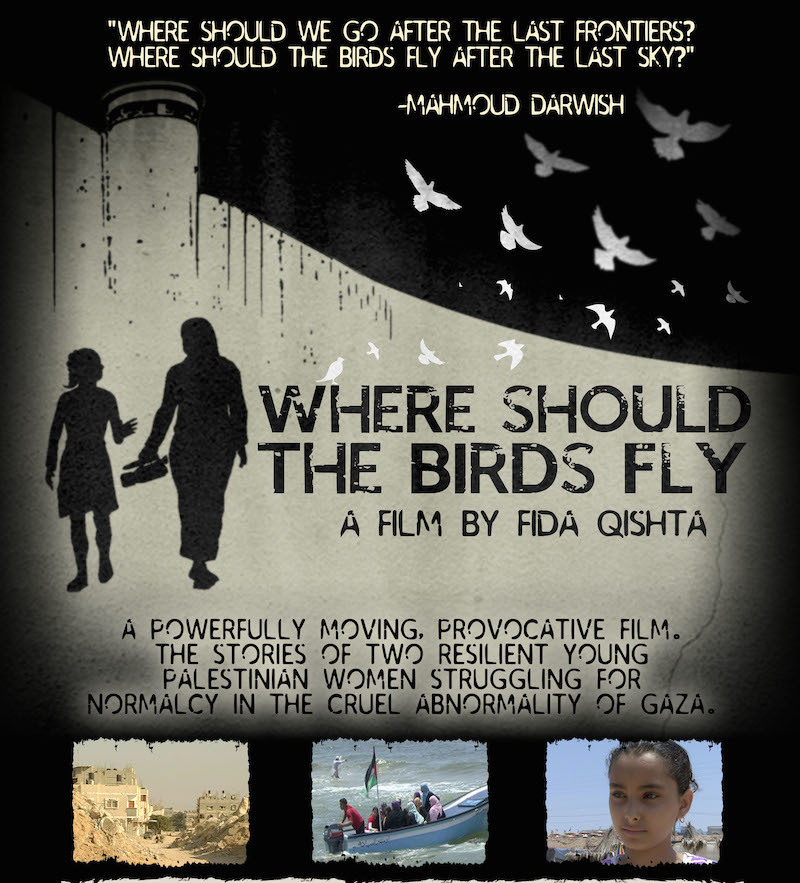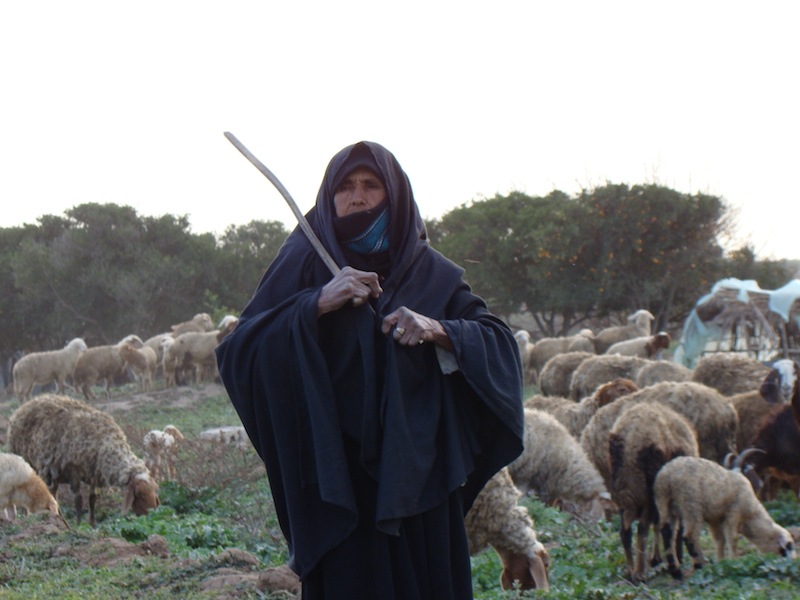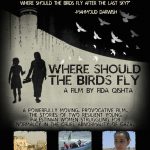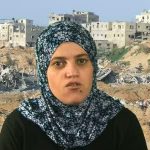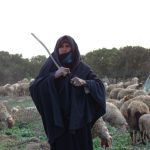Where Should the Birds Fly
Dir. Fida Qishta, Palestinian Territories, 58min, 2013, color, documentary. Japan Premiere! Not recommended for children under 15.
WSBF.trailer.subbed from UPAF on Vimeo.
Fida Qishta, a native of the Gaza Strip, grew up in the continuing conflict and witnessed her parents’ house of 30 years bulldozed by the Israeli army. Soon the young woman, taking a video camera as a weapon, became the first Gazan female video journalist, and started documenting the destruction inflicted on her people. While her commentaries and video reports have been published in Western news media, this film is the first film about Gaza made by Palestinians living the reality of Israel’s siege and blockade of this tiny enclave.
Individuals appearing in the film are ordinary people: farmers and fishermen, but their lives are far from ordinary. Why have these innocent people been virtually imprisoned and why has the world turned a cold eye towards them for decades? Who sees those shocking images? Mona, a 10-year-old girl, saw many of her family members killed in front of her eyes. Fida sees Palestine’s past and future in Mona. Fida says she wanted to express hope for Palestine. Can we, the residents of a far away nation, detect their faint hope? Does Japan really have nothing to do with their struggles? Japan premiere. Skype talk is planned w/ director Fida Qishta.
DIRECTOR’S STATEMENT
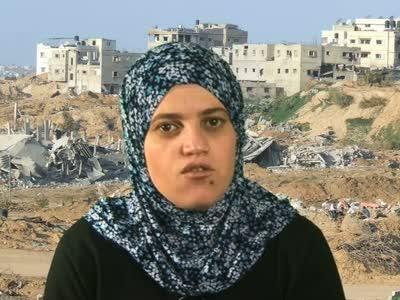 There were occasions when I wished I had a camera. Like the day my family home was demolished. I didn’t have a camera. There was a person with a camera there, but he had been afraid that the Israeli tank might fire at him. He left the camera in the middle of the street and ran to my uncle’s house.. I picked up his camera and he gave me directions about how to film the scene. “
There were occasions when I wished I had a camera. Like the day my family home was demolished. I didn’t have a camera. There was a person with a camera there, but he had been afraid that the Israeli tank might fire at him. He left the camera in the middle of the street and ran to my uncle’s house.. I picked up his camera and he gave me directions about how to film the scene. “
It wasn’t a choice. Sometimes things happen in our life that you need to talk about. And filming is even more powerful. Actually, years ago, one of my friends asked if I would like to be a filmmaker or a journalist. I said no, because it requires travel. If you want to make a story about people in Africa, you have to go there so you know about the people.
Then a friend of mine and I went to a home to speak to a family whose five year old daughter was killed. Going to kindergarten, the child was caught in cross fire when some masked men were shooting at a guard tower. I was only translating so I didn’t really catch the import of what happened to her.
When we went back to edit, I thought, wow, I should have been there to get the story. But I had missed it because I was translating. Watching the footage made the story so alive. That day I started to think of filmmaking. How it could impact people, including Palestinians themselves who live thinking the things that happen to the are normal, just a part of their lives.
There were a few occasions when I wished to have a camera and I didn’t. Like the day my family home was demolished. I didn’t have a camera. But a camera person there had been afraid that the tank in the middle of the street might fire at him, so he ran away to my uncle’s house and left his camera in the middle of the street. I picked up his camera and he gave me directions about how to film the scene. When I lost my best friend I wished I had some video to document and remember her.
I started to work with internationals in 2003 and 2004. Most of them had cameras. I translated for them. In 2005 and 2006, I started to shape my dream. With video, I could speak about the story of my house without speaking another language. That’s when I started to believe in the camera as a language.
In 2006, I came to the US to speak about the situation in Gaza. Some people were asking “How did this thing or that thing happen ?” My language wasn’t good enough to tell them everything I went through or exactly what the situation was. I thought, if I had a camera, I wouldn’t have let these details slip away.In particular, one person was asking about Rafah – “What happens in the home demolition, are people compensated, where do they go?” If I were filming, I could tell the story of how people left their houses, went to a school for shelter, stayed with others, then eventually got settled into a new home.
When I returned to Gaza in 2006, a group of internationals bought me a camera and I started to film.
In 2009, when Gaza was attacked, most internationals left. There were no journalists. The only people filming were from Gaza, myself included. But, because they weren’t English speakers, others talked about their footage. I thought this wasn’t fair. I wanted to tell my story. It’s not enough toot have someone come for two weeks, hear a story, then leave.
I started to learn the process of editing. When the war ended. I saw how much material I had. I started to digitize my tapes and sent some to people in the U.S. to use and to keep safe.
The Guardian newspaper invited me to the UK to learn more about editing. I traveled around Europe and then to the US. I realized I had 100 hours of tapes People asked about the situation in Gaza, making me want to tell the story. Not just my story, but how people see it. On TV, you see the story the producer wants to show, not necessarily what people have been through.
— Fida Qishta
CREW BIOGRAPHIES
Fida Qishta
Director
Fida Qishta is a Palestinian camerawoman/editor and filmmaker, born in Rafah City in the south of Gaza. Since 2006 she has worked as a journalist, producing news stories and documentaries in the Gaza. Her articles have appeared in the U.K. Observer and Guardian newspapers and The International Herald Tribune. She is a qualified teacher and in 2004 founded the Life Makers Center in Rafah, Gaza to teach English and drama to traumatized children. In this film Fida has documented the horrific Israeli invasion and bombardment of Gaza in December 2008 and January 2009. She and her crew of 9 young videographers kept their cameras rolling for months, recording the struggle of the people of Gaza to retrieve some sense of normalcy from the absolute abnormality of life in the world’s largest prison camp, sealed off on all sides by Israeli and Egyptian walls,
barbed wire and military. Where Should The Birds Fly is her first feature documentary film.
Gladys Joujou
Editor
Gladys Joujou is a well respected film editor based in Paris, France. She began her career over 10 years ago and has worked on numerous feature length and short narrative and documentary films. She is fluent in French, English and Arabic.
Her credits include: Oliver Stone’s Alexander with Angelina Jolie and Colin Farrell, Michel Kammoun’s award winning film, Falafel, and Randall Wallace’s The Man in the Iron Mask with Leonardo DiCaprio, and Jacques Doillon’s Raja.
Film Festivals:
2013 Al Jazeera Documentary Film Festival
2013 Edinburgh Film Festival
2013 AFI Silver Docs
2013 Houston Palestine Film Festival
2013 Chicago Palestine Film Festival
2013 Honolulu Film Awards
2013 Dallas International Film Festival
2013 Traverse City FIlm Festival
2013 Ann Arbor Film Festival
2013 Full Frame
2013 San Francisco Independent Film Festival
2013 Globians Doc Fest
2013 Atlanta Film Festival
2013 Big Cause Docu Fest
2013 Los Angeles Women’s International Film Festival
2013 DOC NYC
2013 Durban International Film Festival
